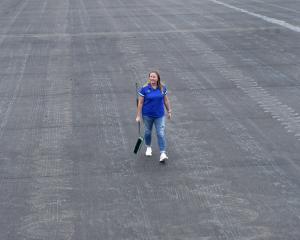The star albatross chick beamed around the world on Otago Peninsula’s "Royal cam" has died after being attacked by her mother yesterday.
The Department of Conservation (Doc) confirmed the death of the chick this afternoon, which has been beamed around the globe by web cam, as the Pukekura/Taiaroa Head colony struggles with a tough breeding season for the colony at Pukekura/Taiaroa Head.
Doc said webcam footage from the northern royal albatross/toroa colony yesterday evening showed female KGY attacking her chick, leaving it with injuries it could not recover from.
The chick was just under a month old.
Doc threatened species ambassador Nicola Toki said aggression by adults and juveniles towards chicks had been seen previously but this was unusual behaviour and Doc weas uncertain why the attack occurred.
"This chick was one of only 16 to hatch this year, as Dunedin’s unusually hot summer has been putting the birds under a great deal of stress.
"With these low numbers, the death of the Royal cam chick is a serious loss to the fragile colony – the only mainland colony of albatross in the Southern Hemisphere.”
"While 29 fertile eggs were laid this year, only just over 50% of these eggs hatched, down from between 70% to 85% in previous years.
"With increasing frequency of extreme weather events due to climate change, the impact of the loss of any individual, for any reason, becomes even more critical for the conservation of the population.”
As well as prolonged high temperatures and the tail end of cyclone Fehi, a lack of wind had been an issue for the nesting birds.
Strong winds were vital for the birds to fly and without them albatross were eventually forced to abandon their nests.
Weather conditions also increased the incidence of fly-strike after hatching with seven chicks being affected contributing to one mortality.
“As a result, there has been a high incidence of embryo death inside the egg and the albatross colony currently has only 14 chicks compared with 26 and 23 at the same time over the last two years respectively,” Ms Toki said.
Much of Dunedin’s most recognisable wildlife was susceptible to climate change.
The Otago Peninsula was within the northern-most ranges of breeding populations of yellow-eyed penguins/hoiho and New Zealand sea lions/rāpoka.
“Living on the warmer fringes of their natural breeding ranges, we would expect these small populations to be most vulnerable to any temperature increases.
"We're beginning to see similar patterns for other native species, where changing weather patterns are compounding existing threats.
"Doc is aware that some native species management practices will need to be adapted to meet the additional challenges brought by climate change," Ms Toki said.
DOC rangers were continuing daily management of the remaining chicks at Pukekura to ensure they had the best possible chance of surviving to fledge (leave the nest).
Management included removal of any maggots, supplementary feeding for chicks and nesting birds, and using hand watering and an irrigation sprinkler system on the headland to help keep chicks and adult birds cool.
Royal cam (www.doc.govt.nz/royalcam) is now back on after being turned off last night.
“We’re committed to keep telling the story of this special colony, complete with all the twists and drama of our incredible natural world>
“We cannot say exactly why this sad event occurred.
"Up until now the chick had been doing well with both parent birds showing normal chick-raising behaviour.
"KGY also has a good record of producing healthy chicks over the years making this behaviour even more unexpected and upsetting for our rangers," Ms Toki said.












